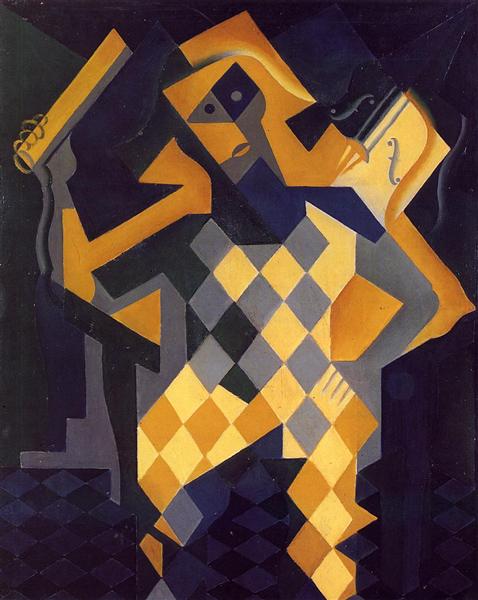Beskrivning
The work "Harlequin with Violin" by Juan Gris is a notable manifestation of Cubism, a style in which the author stood out as one of the most representative. Painted in 1919, this painting presents a fascinating approach to the decomposition and recomposition of form and the use of color, which are essential characteristics of Cubist aesthetics. In the composition of this painting, the harlequin, an emblematic figure of comedy and theatrical tradition, becomes the protagonist, thus giving a metatheatrical character to the work.
Visually, the harlequin is depicted in a series of interlocking geometric planes, uniting the human figure with the surroundings. His face, which appears to be a mask, reflects an air of enigma and detachment. The color palette employed is rich and varied, with predominant shades of yellow, brown, and blue intertwining in faceted shapes. This choice of colors gives the work an emotional depth, while suggesting an almost melancholic atmosphere, a trait often found in the works of Gris, who, despite his unmistakably joyful and vibrant style, addresses themes of emotional complexity.
The harlequin is holding a violin, reinforcing the notion of music as a central element in the scene. This choice is not accidental, as the violin symbolises both joy and sadness, and can be interpreted as the duality inherent in life itself. The use of the violin may also allude to the metamusic of Cubism, where each fragment of the composition becomes a symbol of human experience, just as music is a representation of emotion and expression.
The background elements, though abstract, complement the figure of the harlequin. The fractal planes that define the environment suggest an atmosphere of action and movement; however, the central figure remains aesthetically isolated, which could be interpreted as a comment by Gris on loneliness and the search for identity in an ever-changing modern world. This contrast between the vitality of the environment and the introspection of the character becomes a meditation on art itself and the existence of the artist in contemporary society.
"Harlequin with Violin" can also be contextualized within the rich tradition of the harlequin in the arts. This character has been a recurring figure not only in painting, but also in theater and literature, symbolizing the ambiguity of life and the plurality of identities. In Gris's painting, the harlequin transcends his usual role in comedy, becoming a symbol of artistic quest and emotional struggle.
In conclusion, "Harlequin with Violin" is much more than a simple representation of a character; it is a work that captures the ethos of the Cubist era, revealing an emotional and artistic complexity that continues to resonate in the contemporary art scene. Juan Gris, through this representation, not only follows in the footsteps of his Cubist predecessors, but creates a work that remains relevant for its ability to evoke profound reflections on identity and artistic expression.
KUADROS ©, a famous painting on your wall.
Hand-made oil painting reproductions, with the quality of professional artists and the distinctive seal of KUADROS ©.
Painting reproduction service with satisfaction guarantee. If you are not completely satisfied with the replica of your painting, we will refund 100% of your money.

